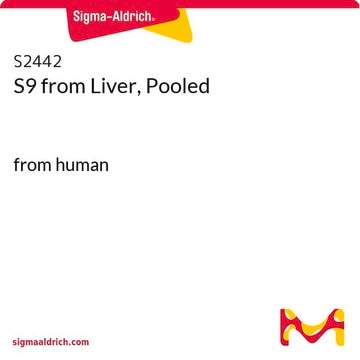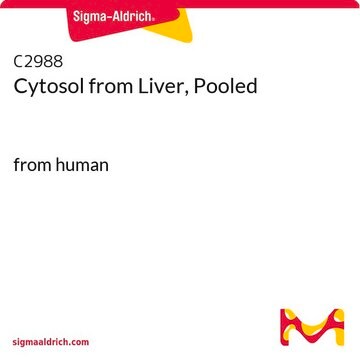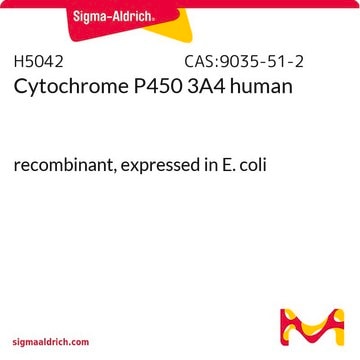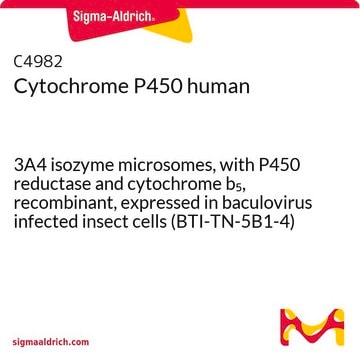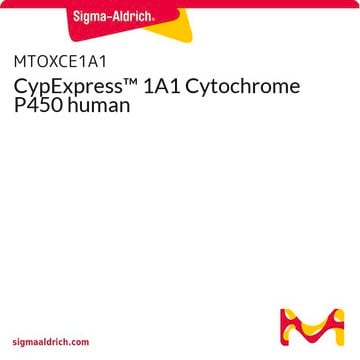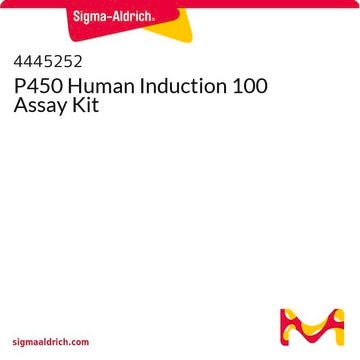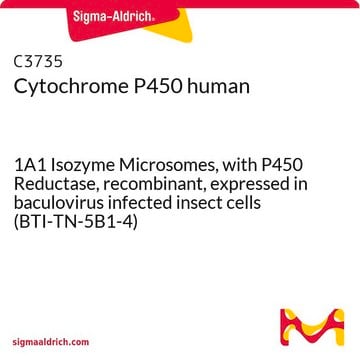Recommended Products
biological source
human male
Quality Level
form
liquid
packaging
vial of ~10 mg
shipped in
dry ice
storage temp.
−70°C
Looking for similar products? Visit Product Comparison Guide
Application
Microsomes from Liver, Pooled has been used:
- in the glucuronidation kinetics assay to test the effects of herbal extracts on glucuronidation process
- as a human liver microsomes (HLM) matrix for testing metabolic stability of talazoparib using liquid chromatography-tandem mass spectrometry (LC–MS/MS)
- to study the metabolization of enantiomeric peptide D3
Microsomes from liver have been used in a study to assess differences in enzymatic activities between normal rat livers and from liver after partial hepatectomy. They have also been used in a study to investigate the carbon monoxide-binding pigment in liver microsomes.
Biochem/physiol Actions
Liver microsomes are subcellular particles derived from the endoplasmic reticulum of hepatic cells. These microsomes are a rich source of drug metabolizing enzymes, including cytochrome P-450. Microsome pools from various sources are useful in the study of xenobiotic metabolism and drug interactions.
N-glucuronidation of various 1-substituted imidazoles was found to occur in human liver microsomes.
Storage Class Code
10 - Combustible liquids
WGK
WGK 3
Flash Point(F)
Not applicable
Flash Point(C)
Not applicable
Certificates of Analysis (COA)
Search for Certificates of Analysis (COA) by entering the products Lot/Batch Number. Lot and Batch Numbers can be found on a product’s label following the words ‘Lot’ or ‘Batch’.
Already Own This Product?
Find documentation for the products that you have recently purchased in the Document Library.
Customers Also Viewed
THE CARBON MONOXIDE-BINDING PIGMENT OF LIVER MICROSOMES. I. EVIDENCE FOR ITS HEMOPROTEIN NATURE.
T OMURA et al.
The Journal of biological chemistry, 239, 2370-2378 (1964-07-01)
Sarvesh C Vashishtha et al.
Drug metabolism and disposition: the biological fate of chemicals, 30(10), 1070-1076 (2002-09-14)
N-Glucuronidation at an aromatic tertiary amine of 5-membered polyaza ring systems was investigated for a model series of eight 1-substituted imidazoles in liver microsomes from five species. The major objectives were to investigate substrate specificities of the series in human
Mohamed W Attwa et al.
Drug design, development and therapy, 14, 4439-4449 (2020-10-31)
Tandutinib (MLN518 or CT 53518) (TND) is a novel, oral, small-molecule inhibitor of type III receptor tyrosine kinases utilized for the treatment of acute myeloid leukemia (AML). In silico prediction of hepatic drug metabolism for TND was determined using the
Mohamed W Attwa et al.
Drug design, development and therapy, 14, 111-119 (2020-02-06)
Larotrectinib (VITRAKVI) is an orally potent tropomyosin receptor kinase (Trk) inhibitor that acts by competitive inhibition of all corresponding receptor kinases. It demonstrated a marked response rate (75%) and robust anticancer activity in Trk fusion-positive patients. This response is independent
Ali S Abdelhameed et al.
Drug design, development and therapy, 14, 5259-5273 (2020-12-11)
Ensartinib (ESB) is a novel anaplastic lymphoma kinase inhibitor (ALK) with additional activity against Abelson murine leukemia (ABL), met proto-oncogene (MET), receptor tyrosine kinase (AXL), and v-ros UR2 sarcoma virus oncogene homolog 1 (ROS1) and is considered a safer alternative
Our team of scientists has experience in all areas of research including Life Science, Material Science, Chemical Synthesis, Chromatography, Analytical and many others.
Contact Technical Service
